Physical Address
304 North Cardinal St.
Dorchester Center, MA 02124
Degeneration of the spine is universal and involves structural changes in the disk, bone, ligaments, and articular cartilage of the facet joints. Despite the high prevalence of degeneration, the underlying etiology is still only partially understood. There is, however, an interrelationship of the different components of the spine in that changes in one component, such as the disk, will have an effect on another, such as altered biomechanics of the facets. Similarly, alterations in the structure of the vertebral end plate may affect the nutrition of the disk and the viability of the chondrocytes.
Degeneration of the spine is a natural aging process and increases in extent and severity with age. Miller and colleagues reported an increase in disk degeneration from 16% at age 20 to 98% at age 70, based on microscopic disk degeneration grades of 600 autopsy specimens. Reduction in disk signal intensity on MRI is one of the degenerative findings most highly associated with age. Environmental factors, such as heavy physical loading related to occupation, have been suggested as a factor, but the evidence is not conclusive and may be influenced by confounding factors, including socioeconomic status and lifestyle. Series of studies with monozygotic twins found that heavy physical loading demands at work and leisure explained only a minor portion of the overall variance in lumbar disk degeneration. Driving has also been proposed as a possible etiologic factor, but the current weight of evidence suggests no notable effect of driving on disk degeneration. The only chemical exposure associated with disk degeneration is smoking.
Finally, there is likely to be a genetic influence on degeneration, and initial results suggested a substantial family influence on degenerative findings. A study of both cervical and lumbar spine using MRI showed that heritable estimates were very high for both lumbar and cervical spine after adjusting for age, weight, smoking, occupation, and physical activity; and disk bulging and height were the primary contributors to the disk degeneration summary score that relate to the genetic determination. Disk bulging and disk height are the individual features that are the most highly heritable in both cervical and lumbar spine.
Low back and neck pain are common ailments in developed countries, with an estimated 40% to 70% of adults having suffered low back pain. Low back and neck pain is a major source of disability and loss of working time.
In most cases, the pain resolves, but recurrent episodes may occur, ranging from 20% to 44% within 1 year after an episode of acute low back pain, with 80% suffering a recurrence within 10 years. For approximately 5% of the adult population, low back pain becomes persistently disabling and chronic. The incidence and prevalence of symptomatic herniated nucleus pulposus are much lower, with 1% of those between 17 and 64 years old reporting discomfort from lumbar intervertebral disk herniation and between 0.1% and 0.5% of the population per year within the age range of 20 to 64 having a new clinically manifest herniated nucleus pulposus, with a peak incidence between 38 and 44 years of age.
There is no correlation between the presence of symptoms and the imaging features of disk degeneration.
Pain may arise from the structures of the spine, referred to as sclerotomal pain, or be due to compression of the nerve roots passing through the spinal canal, called dermatomal pain. The sclerotomal pain may be localized to the spinal region or may be referred to adjacent areas or to the limbs. Cervical sclerotomal pain is often referred to the shoulder, and lumbar pain is often referred to the buttocks and thighs, although more distal limb referral may occur. Dermatomal pain may also be present in the region of the spine but will often be present in the limbs in the distribution of the compressed nerve.
The discogenic pain is exacerbated by activity such as bending or lifting and relieved by rest, especially in recumbency. The individual begins the day relatively free of pain. Patients may occasionally find themselves immobilized by pain and spasm. On examination, the erector spinae muscles are tense and movement is limited, and there may be a variable degree of tenderness on palpation. Neurologic examination does not identify any objective loss, although straight-leg raising may be limited.
Facet pain may be aggravated by rest, resulting also in sleep disturbances, whereas movement decreases pain. Pain and stiffness are present on rising but improve during the day. Symptoms may be exacerbated by extended periods of sitting or standing with the spine in a lordotic position. Examination is unremarkable except that the patient may flex the cervical spine or touch the toes but may be significantly restricted in extension. Deep palpation may reveal tenderness in the region of the affected facet joints and no neurologic deficit.
Discogenic and facet pain may occur together, resulting in a combination or mixture of clinical features sometimes resulting in constant pain, marked restriction of spinal movement in all directions, and considerable tenderness.
The pain in nerve root compression by degeneration in the spine is usually in the distribution of the nerve root but may not affect the whole extent of the distribution, and there is overlap between dermatomes. In the cervical spine, compression of the cord may also affect the distribution of the pain; in the thoracic spine, disk herniations commonly present as back pain that is nonspecific or a myelopathy that includes progressive paraparesis, hyperreflexia, altered sensation and pinprick levels, and, occasionally, urinary problems. Nerve root compression will also lead to motor and sensory changes, and examination includes assessment of motor strength, sensory loss, and deep tendon reflexes in the extremities. Central nuclear herniations may produce severe back pain and bilateral leg pain. Lesions of the peripheral nerve roots must always be distinguished from root irritation by the degenerate spine. Pain from root compression in the upper cervical spine may extend into the occiput.
The spine consists of a column of vertebrae with a vertebral body linked by two pedicles to the lamina, which has two superior and two inferior articular processes and a spinous process. Each vertebra, with the exception of the sacrum and coccyx, is linked as a three-joint complex. The intervertebral disk with associated vertebral cartilage end plates forms the anterior component, whereas the facet joints form the posterior component. The intervertebral disk is made up of two components, the outer being the annulus that surrounds the inner nucleus pulposus. The annulus is divided into outer and inner concentric rings with dense fibrous lamellae containing fibroblasts in the outer ring and less densely packed collagen with chondrocytes and some ground substance in the inner ring. The central nucleus pulposus has an infrastructure of collagen with chondrocytes and a high content of hydrophilic proteoglycans and therefore water content. The intervertebral disk and adjacent vertebral end plates form a continuum with the collagen fibers of the disk passing directly into the cartilage of the central part of the vertebral end plate and directly into the bone at the anterior and posterior rims of the vertebra, called the enthesis. Because the intervertebral disk is avascular, it obtains most of its nutrients by diffusion through the cartilage end plate from the vascular arcade along the subchondral trabecular bone, with a small component in the outer annulus from vessels around the outer rim of the disk. The transport of water, nutrients, and metabolic waste products to and from the disk is enhanced by pressure, and the nucleus pulposus loses water and metabolic waste products during the day in the upright posture, resulting in reduction in height; while a person is in the recumbent position, water and metabolites reenter the disk, increasing its height.
The facet joints have appositional articular cartilage surfaces and are lined by synovium. The inner capsule is continuous with the ligamentum flavum, and the outer capsule is covered by the ligaments. The alignment of the facets is site-dependent, with more horizontal alignment in the cervical spine that facilitates flexion and extension, with some limited potential for rotation and lateral flexion. In the thoracic spine, the facets have coronal and more vertical alignment, and there is only a limited range of movement. In the lumbar spine, the upper facets are aligned vertically in the sagittal plane but become more coronal in the lower lumbar spine.
The motion segments are connected throughout the spine by the anterior and posterior longitudinal ligaments, the ligamentum flavum, and the interspinous ligaments posteriorly. The anterior longitudinal ligament is attached to the anterior vertebral wall and end-plate rim but is not attached to the intervertebral disk. The posterior longitudinal ligament is inserted at the enthesis of each vertebral end plate and is firmly attached to the intervertebral disk by lateral expansions but is not attached to the posterior wall of the vertebral body.
In the lumbar spine, the anterior elements of the vertebral column are surrounded by a plexus of nerves derived anteriorly from the sympathetic trunks, laterally from the gray rami communicantes, and posteriorly from the sinuvertebral nerve. The plexuses supply the anterior longitudinal ligaments, the periosteum of the vertebral body, the penetrating branches into the vertebral body, the posterior longitudinal ligament, the ventral aspect of the dural sac, and the outer third of the annulus.
The facet joints are innervated by the medial branches of the dorsal rami and have multisegmental innervation.
The epidural space mainly contains fat and blood vessels, which make up the epidural venous plexus. The anterior epidural veins pass over the disks on either side of the midline. The vertebral bodies are supplied by a central artery that arborizes to the vertebral end plates, and the veins drain back into a central vein in a similar fashion.
The vertebral/intervertebral disk combination, pedicles, facet joints, and foramina at each level also provide a conduit for the spinal cord and nerve roots. The cord terminates at T12 to L1 and becomes the cauda equina. Nerve roots emerge from the dural sac passing under the lamina and out through the foramina.
Degeneration is a natural process in the spine, with autopsy studies showing changes of spondylosis in 60% of women and 80% of men by the age of 49 years and in 95% of both by the age of 70. Disk degeneration begins with a gradual loss of hydration of the nucleus with a drop from 90% at birth to about 75% in the third decade. There is a gradual centripetal encroachment of collagen into the nucleus from the annulus, a reduction of chondrocytes, and changes in the proteoglycans of the nucleus. Subsequently, the nucleus becomes solid, non-turgescent, and dry, with a marked increase in collagen content and no discernible differentiation from annulus. In middle age, splits and clefts form parallel with the end plate toward the upper and lower parts of the nucleus, and, as aging progresses, they extend to the outer parts of the annulus, where vascular ingrowth may occur. In the annulus, initially fragmentation of fibers, mucinous degeneration, and cracks and cavities occur that may result in tears at the annular rim of the vertebral body, which are commonly present by age 50 years. Concentric circumferential cracks or tears develop between the layers of the collagen in the annulus, and radiating ruptures may also occur radially from the nucleus to the periphery. These radial tears may or may not extend through the outer annular fibers and are also the conduit for nuclear material to pass through the annulus and produce a herniation of the nucleus pulposus. Such prolapses have been shown to often contain fibrocartilage in both the cervical and lumbar spine. Early degenerative changes of the cartilage end plate include fibrillation, longitudinal fissures, and cleft formation. This may also be enhanced by calcification of the end plates and occlusion of the marrow contact channels that is observed with advancing age. As degeneration progresses, there is extensive loss of cartilage with vascular ingrowth and ossification with islands of residual cartilage. The irregular ossification may be extensive with dense bony sclerosis in the adjoining vertebral bodies and irregularity of the residual vertebral bony end plate.
Osteophyte formation at the peripheral margins of the vertebral bodies is present where there are degenerative changes in the disk. They form initially at the vertebral rim by advancing endochondral ossification of the annulus and increase in size by the formation of subperiosteal new bone. The osteophytic bone is initially coarsely trabeculated or compact but becomes cancellous with marrow cavities continuous with the vertebral body and may vary in size but only rarely becomes united across the disk.
Degeneration may affect a number of motion segments but most commonly involves the mid-cervical and lower lumbar spine. In some cases, it may begin at a relatively early age and be associated with trauma or overuse. Degeneration may also result in compression of the cord or nerve roots due to herniation of the nucleus pulposus through the annulus, bulging of the annulus, osteoarthritis of the facet joints, or instability of the motion segment secondary to the degenerative changes.
Radiographs of the spine delineate the vertebra satisfactorily but have significant limitations in demonstrating spinal soft tissue. The demonstration of disk changes is limited to the evaluation of disk height; although the later stages of disk height loss are clearly demonstrated ( Fig. 45-1 ), early disk space loss may be subject to interobserver variation and difficulties of lateral angulation and rotation of the radiographs. Comparison is made to adjacent disks to see early reduction, but it should be noted that disk height normally gradually increases in the lumbar spine between L1 and L4 to L5, whereas L5 to S1 height is, again, less. Disk space narrowing may be asymmetric and should be assessed on both anteroposterior and lateral views of the spine. Bony vertebral end-plate irregularity is usually accurately assessed, but sclerosis is a relative feature and varies normally between subjects and may be limited to part of the end plate if there is asymmetric narrowing and, particularly, if it is related to vertebral osteoporosis. In the thoracic spine, disk space narrowing associated with end-plate irregularity may be seen in conjunction with loss of anterior vertebral height. Although individual disk levels may be affected, if three or more consecutive disk levels are involved, it is referred to as Scheuermann disease, and the presence of these changes in adolescence may result in a degree of kyphosis in severe cases.
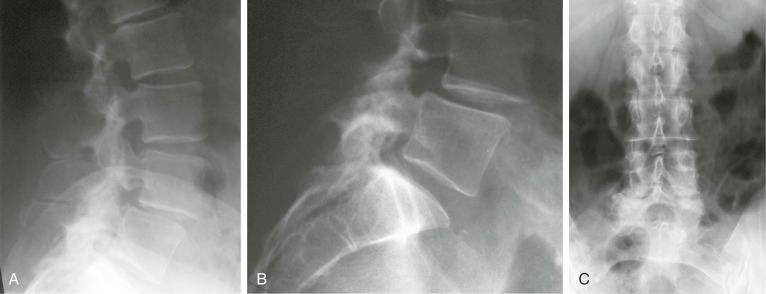
A vacuum phenomenon appearing as low attenuation areas within the disk may be seen that is enhanced by extending the spine. These areas may be limited to the vertebral rim at the insertion of the annulus and may be associated with osteophyte formation. A vacuum phenomenon within the disk substance reflects the cleft formation and is also helpful in excluding infective pathology, which is rare as a cause of disk gas.
The presence of total disk resorption with severe sclerosis of the end plate at only one level in an otherwise normal-looking spine is seen in some younger patients and has been reported as a separate entity.
Multiple disk space narrowing, sclerosis, and osteophyte formation may be present in older subjects in the cervical ( Fig. 45-2 ) and lumbar spine and may be associated with a degenerative scoliosis in the latter, with asymmetric disk space narrowing.
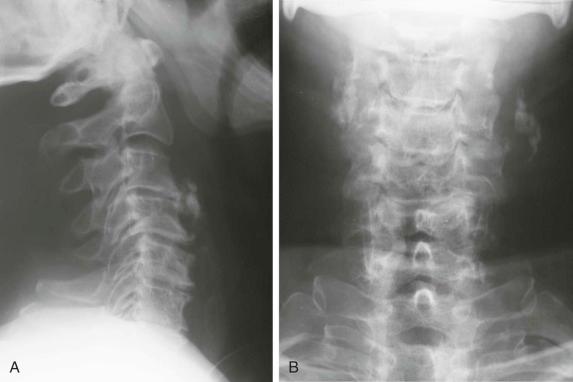
Osteophytes appear as bony projections from the rim of the vertebral body usually slightly below the end plate, less commonly from the end-plate rim. Osteophytes must be differentiated from the flowing ossification of the anterior longitudinal ligament of diffuse idiopathic skeletal hyperostosis (Forestier disease), which may bridge the whole disk space and involves the anterior surface of the vertebral body.
Lateral radiographs in flexion and extension have also been used to evaluate relative linear and rotational interbody displacement. The normal range of movement has been a subject of dispute. In both the cervical and lumbar spine, translation in the lumbar spine of 4 mm or more was seen in 20% of normal subjects, and 10% had 3 mm or more at all levels except from L5 to S1.
The process of intervertebral disk degeneration is best visualized on MRI. The normal nucleus is high signal on the spin-echo, T2-weighted MR sequence, and the surrounding annulus is of low signal. The appearance of the disk on a T2-weighted, spin-echo MR sequence has been graded by Pfirrmann and colleagues ( Table 45-1 ; Fig. 45-3 ). Grade I is described as a “cotton ball” with a uniform high signal throughout the disk and is the appearance in young people. Grade II differs only by the presence of a central horizontal low signal cleft and is also considered to be normal. In grade III, there is a reduction of high signal in the nucleus without loss or with minor loss of disk height representing the early stages of degeneration, and there may be loss of distinction between the nucleus and the annulus. Grade IV shows some loss of disk height, which can also be appreciated on radiographs, with a generalized loss of signal. Grade V represents the end stage with almost complete loss of the disk space.
| Grade | Differentiation * | Signal Intensity † | Disk Height |
|---|---|---|---|
| I | Yes | Homogeneously hyperintense | Normal |
| II | Yes | Hyperintense with horizontal dark band | Normal |
| III | Blurred | Slightly decreased, minor irregularities | Slightly decreased |
| IV | Lost | Moderately decreased, hypointense zones | Moderately decreased |
| V | Lost | Hypointense, with or without horizontal hyperintense band | Collapsed |

This grading system has good intraobserver and interobserver correlation and is useful as a descriptive method, although there is no relationship with symptoms. Disk height may be measured on the monitor directly, and special techniques may be used, but comparison with an adjacent disk is most commonly used. The degenerative process also results in the annulus losing its strength and bulging outward beyond the outline of the vertebral rim. This is a circumferential process, although it may be greater in one area than another, depending on the compressive forces on the disk. In the axial plane, the annulus is seen extending beyond the vertebral body outline uniformly around the whole vertebra, and, on sagittal MR images, the annulus will be seen to be bulging beyond the vertebra on each section ( Fig. 45-4 ). Cervical disks begin the process of degeneration at a relatively early age with the development of clefts in the posterolateral aspects of the disk from the nucleus into the neurocentral joints.
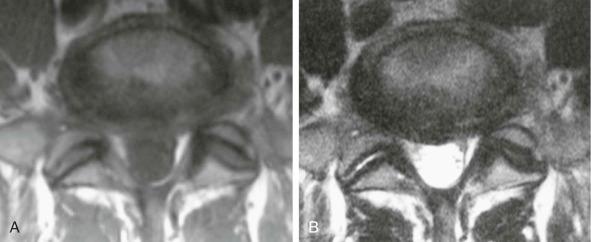
Focal linear areas of high signal within the degenerated disk occasionally occur that are thought to be due to free water within degenerate clefts.
The presence of gas in the disk may result in low signal on T1- and T2-weighted images. Calcification within the degenerated disk will produce low signal on T1, but, occasionally, fine calcification may lead to T1 shortening and increased signal intensity.
Although MRI demonstrates the features of degeneration well, attempts to predict the source of back pain have proven unreliable, especially when more than one disk has degenerated. If accurate delineation of a painful level is required before surgery, an injection of water-soluble contrast agent into the nucleus will confirm the degenerate changes and may provide confirmation of the disk as a source of pain ( eFig. 45-1 ). CT may be performed in conjunction with the injection because this enables internal annular changes to be demonstrated as concentric rings of contrast medium and therefore the degree of degeneration to be graded. A good correlation between discographic and MR morphology has been shown, but discograms have identified abnormalities on apparently normal MR images.
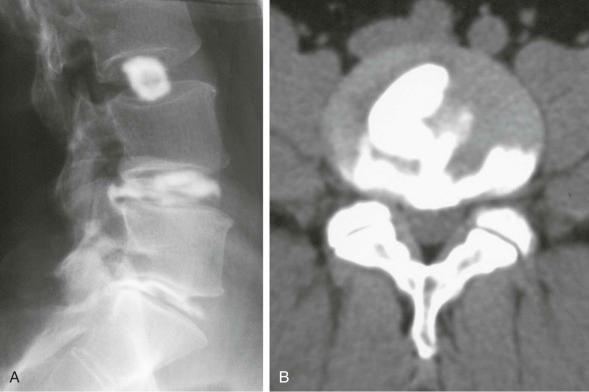
Pain production is assessed during and after injection of the contrast agent and is rare if the disk is normal. Symptom provocation from degenerated or injured disks is variable, but, in a study of discography in asymptomatic control subjects, pain was not produced from abnormal disks, although others have found a higher false-positive rate. The diagnostic accuracy of discography is still unclear because double-blind controlled trials have not been performed. However, using successful surgical fusion as an end point, an 82% accuracy with an 89% sensitivity has been recorded. The specificity was low at 43%, but abnormal disks with no pain reproduction that were left at surgery did not result in poor results. However, if discography is used only for cases in which all other clinical and diagnostic criteria for the diagnosis of discogenic pain are fulfilled in sequence, the false-positive rate is decreased. Discography is most accurate and useful when the diagnosis of discogenic pain is highly probable.
In the cervical spine, there is a greater degree of discordance between MRI and discography because of posterolateral cleft formation. The accuracy of cervical discography is less clear, and there is an increased potential for infection in the disk after the investigation.
Clefts may develop in the annular fibers between the concentric fibers or in a radial pattern, or a combination of the two may occur. This process may be associated with a traumatic episode, particularly in younger patients, but it has been demonstrated with increased frequency with age, as shown in cadaver studies. These clefts are demonstrated by MRI and discography only.
The posterior tears can be seen on MR sagittal studies. The disk height is usually maintained on the T1-weighted image and is associated with a small central bulge of the posterior annulus on the midline image and on the axial scan through the disk. On T2-weighted, fast spin-echo MR sequences, there is a high signal intensity linear track through the low signal annulus and a small central bulge. In some cases, they may be seen as a bright focus within the outer annulus, which is separated from the remainder of the nucleus as a high intensity zone ( Fig. 45-5 ). Posterior annular tears may not be visible on MRI; compared with cadaver anatomic sections, MRI had only a 67% sensitivity. If gadolinium contrast is injected, enhancement of the posterior annular cleft may be visualized, and enhancement of the posterior annular tear almost always occurs in the presence of a high intensity zone.
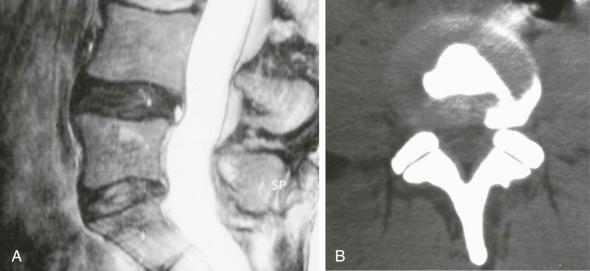
Posterior annular tears are best demonstrated by discography with the injection of contrast medium directly into the nucleus, followed by CT, which will define the pattern of flow in the annulus. The tears with high intensity zones on MRI have been shown on CT discography to represent a combination of radial and concentric tears (see Fig. 45-5 ), and the significance in relation to symptoms has been the subject of considerable debate. Aprill and Bogduk found that the presence of high intensity zones had a positive predictive value of 86% for a severely disrupted and symptomatic disk. They concluded that a high intensity zone was a sign of painful internal disk disruption. Subsequent investigators looking for correlation between high intensity zones and pain on discography have come to conflicting conclusions. The sign has also been reported to have a high specificity and positive predictive value (95.2% and 88.9%, respectively) for discography-induced pain but was limited by poor sensitivity (26.7%). A high rate of concordance between high intensity zones and painful discography was also reported by other authors. However, other studies have also found no statistical correlation between the presence of high intensity zones and pain response on discography. To further complicate this issue, discographic injection in subjects with high intensity zones provoked significant pain in approximately 70% of subjects, whether symptomatic with low back pain or not.
In studies of MRI of the lumbar spine, high intensity zones have been reported to be a common finding (prevalence, 45.5%) in patients with low back and leg pain, but a group of patients with particular clinical features was not defined. A high incidence of high intensity zones in asymptomatic volunteers between ages 20 and 50 years (32% and 33% between two observers) has also been reported. A recent study of the natural history of high intensity zones has shown that many stay unchanged, whereas others regress or increase in intensity and that no correlation existed between improvement or exacerbation of high intensity zones and changes in symptoms. On the basis of all available evidence, posterior annular tears increase in incidence with age and are common in the asymptomatic population. They may be a source of pain, but it is uncertain whether high intensity zones are more commonly painful than other posterior annular tears.
Become a Clinical Tree membership for Full access and enjoy Unlimited articles
If you are a member. Log in here